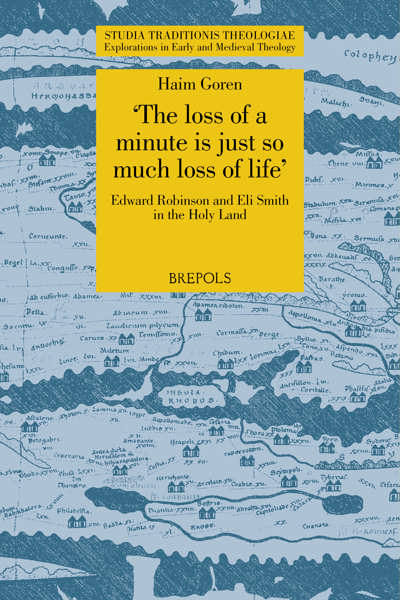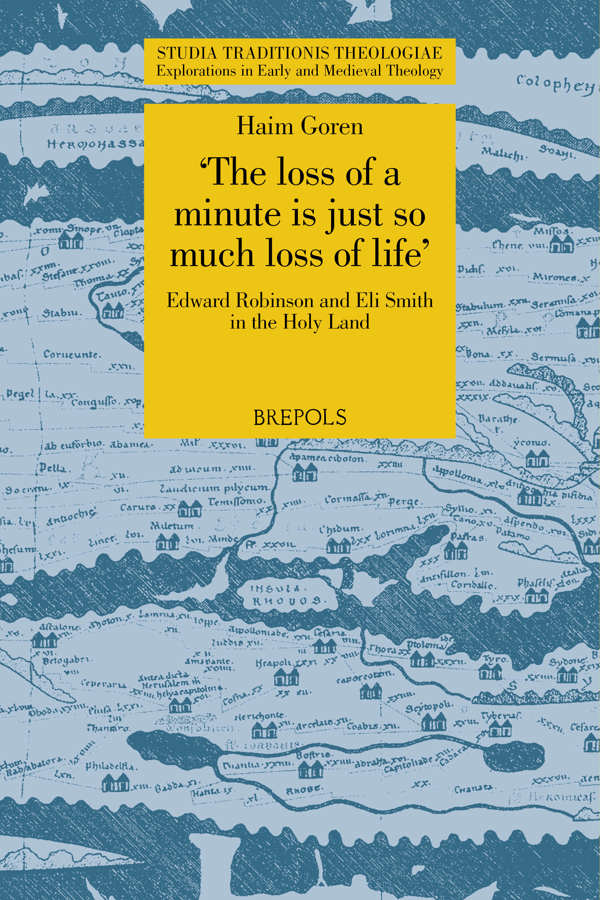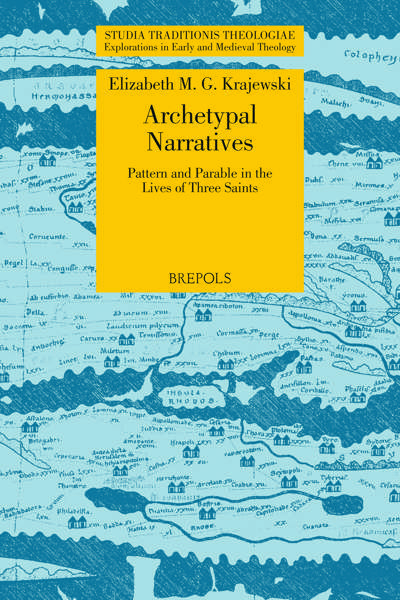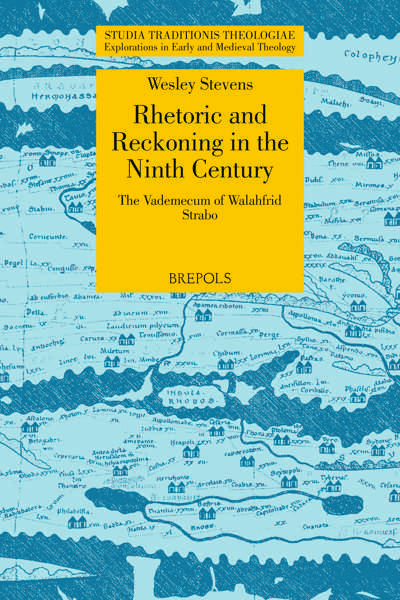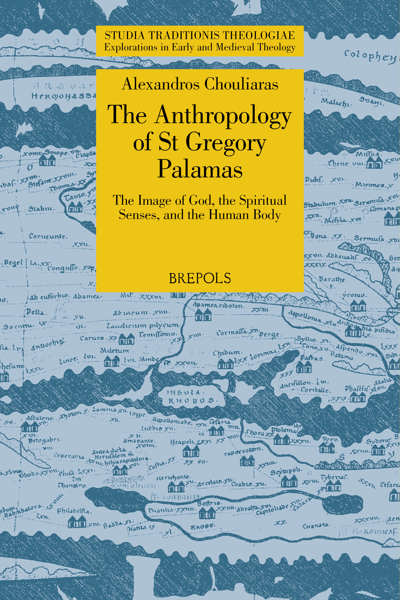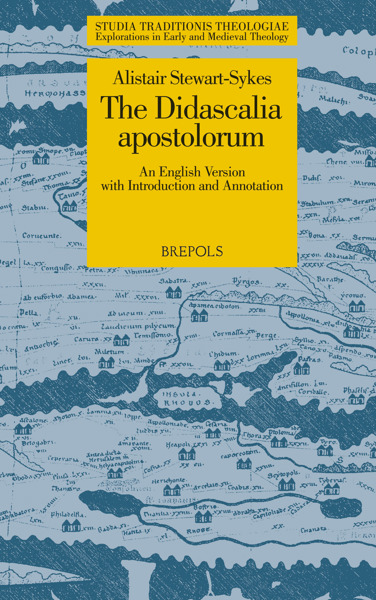
'The loss of a minute is just so much loss of life': Edward Robinson and Eli Smith in the Holy Land
Haim Goren
- Pages: xx + 339 p.
- Size:156 x 234 mm
- Illustrations:25 b/w, 8 col., 1 tables b/w., 2 maps color
- Language(s):English
- Publication Year:2020
- € 80,00 EXCL. VAT RETAIL PRICE
- ISBN: 978-2-503-58913-8
- Paperback
- Available
- € 80,00 EXCL. VAT RETAIL PRICE
- ISBN: 978-2-503-58914-5
- E-book
- Available
The different story of the travels and publication of Edward Robinson, ‘Father of Holy Land Research’ in the 19th century, as described in letters and documents.
"Many books have been written about Edward Robinson. What make Goren's work different is that it describes the process through which Robinson's research on biblical Palestine was written. (...) Yet, what makes Goren's research unique is the use of the personal correspondence between Robinson and Reverend Eli Smith, Robinson's companion in his first voyage to the Holy Land and his co-author of the Biblical Researches. (...)
Whereas most studies that deal with the history of Biblical Researches have nearly never mentioned the role of Eli Smith in Robinson's preparation for this work, Goren brings Smith back “to life” and underscores his participation in the 1838 expedition to Palestine, his knowledge of the Arabic language – he was once described as "America's first Arabist” - and his role concerning the naming of places, objects, and subjects during the expedition. (...) Goren's unique and wonderful book constitutes a crucial introductory piece to those interested in the historical geography of the Holy Land and, more specifically, in Robinson's Biblical Researches." (Gideon Biger, in Journal of Historical Geography, https://doi.org/10.1016/j.jhg.2022.10.001, Available online 28 November 2022)
"This book should be on the shelves of all who salute the names of Robinson and Smith, and should encourage those who have not read Biblical Researches to read them. (...) Much of this might have been put together from previously published sources, but this is where we must pay full tribute to Haim Goren. His book is based on the massive archives of the correspondence of Robinson, Smith, and others involved in the story. (...) We owe heartfelt thanks to him for revealing Robinson, Smith and Talvj as such fascinating people." (J. R. Bartlett, in Palestine Exploration Quarterly, DOI: 10.1080/00310328.2021.1901378, 22 March 2021)
"Prof. Haim Goren is a historical geographer and a prominent scholar in the study of the journeys and research conducted by European men of science and religion in the Land of Israel during the 19th century. (...) His current book centers on one of the most renowned of these explorers: American scholar Edward Robinson, known nowadays mostly for Robinson's Arch. (...) However, Robinson's important archeological discovery was but a fraction of his achievements, as exemplified in Goren. (...) This book constitutes an antithesis to research that relies on general and all-encompassing theories, and does not present the works of Robinson, Smith and others in a manner that obscures their individuality as scholars and personal identities. This book examines them, not as part of an ensemble of men of science who acted as the emissaries of Western colonial imperialism, but as individuals with scholarly interests, whose goal was discovery: Edward Robinson's journey to the Holy Land aimed to unveil and uncover the past as it truly was. Nevertheless, we must take heed, not only of the overall contexts of these men's scientific work, but also of their research in and of itself; its contribution to our understanding of the past, both biblical and 19th century; their thorough and meticulous method; and the quality of their scientific work. Regarding these subjects, there is much for Haim Goren's book to teach us." (Arnon Golan in Cathedra Quarterly, October 2021, p. 179-183 [in Hebrew])
“Goren’s archival study represents an important contribution to the history of exploration in the southern Levant and will serve as a useful reference for future scholars.” (David M. Jacobson, in Strata: Journal of the Anglo-Israel Archaeological Society, 39, 2021, p. 227)
Haim Goren (1946-2025) was Professor Emeritus of Historical Geography at Tel-Hai College, Upper Galilee, Israel. His fields of research were historical geography of Palestine / Eretz Israel and the Near East in the 19th century up until World War I. In 2017 he published a narrative based upon research of archival letters and contemporary and modern studies, titled 'Edward Robinson, Eli Smith and the Cartography of Berghaus and Kiepert', in Mapping the Holy Land: The Origins of Cartography in Palestine (with Jutta Faehndrich and Bruno Schelhaas, London, 2017). The current book is, in many ways, a continuation of this study.
Perhaps no other Palestine / Holy Land explorer has received as much attention as Edward Robinson, the American philologist, theologian, and historical geographer responsible for laying the foundations for the modern historic-geographical study of the Holy Land. Surprisingly, to date, almost no one has delved into Robinson’s archive to illuminate his Holy Land expeditions, the writing of his monumental Biblical Researches, and the compilation of his fine maps. Similarly, no one has conducted a detailed study of the archive of Eli Smith, American Board of Commissioners of Foreign Missions Beirut missionary and Robinson’s travel companion, for the same purposes. Fluent in Arabic and highly familiar with the region and its inhabitants, Smith’s contribution to the expedition and to the Biblical Researches was considerable as his archive reveals.
Investigating documents in both Robinson’s and Smith’s archives, the author of the present book became quickly convinced that much of the accepted narrative concerning Robinson's Holy Land studies should be re-evaluated and, consequently, rewritten. Several issues, for lack of relevant sources, have not yet been addressed by scholars. The story of Robinson and Smith’s expedition and writing of the Biblical Researches that emerges from their extensive correspondence underscores the difficulties they overcame, and the accuracy and magnitude of their scholarship in an age bereft of modern technology.
List of Illustrations
Preface
Acknowledgements
Edward Robinson 1794-1863: A Short Biography
1. Introduction: The Archives of Edward Robinson and Eli Smith
The introduction reviews the vast and different collections of archival materials consulted for this study.
2. The 1838 Expedition to the Holy Land: Origins and Preparations
2.1 Documenting the decision to embark and expedition preparations
Robinson’s decision-making process, beginning with his pivotal 1832 meeting with Smith in Andover, MA, until embarking on the expedition in Spring 1838.
2.2 Robinson’s German period: Seeds of the Holy Land expedition
Robinson’s desire to embark on a scholarly expedition to the Holy Land was influenced by the example of leading German scholars he met while studying in Halle and Berlin from 1826 to 1830.
2.3 Developing a historical-geographic approach to the Scriptures.
‘The father of Holy Land studies’ developed a unique and innovative method for scholarly investigation of the land of the Scriptures.
2.4 Organizational and technical matters
3. The 1838 Expedition: Itinerary and Development
3.1 Financing the expedition
3.2 Robinson and Smith’s descriptions and comments of events en route
Based upon archival material, the story of their everyday life, contact with locals and dignitaries.
4. In Berlin and Halle: Writing the Biblical Researches
4.1 The post-expedition journey: Robinson and Smith to Germany
Robinson’s and Smith’s travel decisions and their impact upon their subsequent research and the dramatic tale of Robinson’s recovery and his wife Talvj’s involvement.
4.2 Return to NY or stay in Berlin? Robinson and his UTS superiors
Robinson initially planned to return to New York and begin teaching at UTS in Autumn 1838, but he actually returned only two years later.
4.3 The Biblical Researches: Planning, writing, and distribution
4.3.1 The preface: Explaining the underlying scientific approach
4.3.2 Origin of the manuscript: From inception to format
4.3.3 The writing begins in earnest
4.3.4 Attention to detail: Arabic place names and orthography
4.3.5 Publishing the manuscript
The Biblical Researches, three volumes comprising more than 600 pages each, was published almost simultaneously in London and in Boston in English, and in Halle in German.
4.3.6 Biblical Researches 1841 – distribution
4.4 Robinson’s secondary sources
Robinson’s amazing use of diverse sources to construct his arguments and the historical-geographic picture of the land and its sites.
5. Co-travelers and Companions
5.1 Eli Smith, the underacknowledged partner
ABCFM missionary Eli Smith, responsible for construction of the Beirut Arabic printing press and the Arabic translation of the Bible, was Robinson’s student and companion on the expedition.
5.1.1 Eli Smith and the German Orientalists
Smith’s contacts with some of the leading German Orientalists developed and strengthened during his nine months in Leipzig after the expedition.
5.2 Therese Albertine Luise von Jakob-Robinson, ‘Mediator of the Balkan Slavs’, and Holy Land Studies
Talvj, Robinson’s second wife whom he married in Halle in 1828, had, until his death, a crucial role not only in his personal and social, but in his academic life as well.
5.3 James Adger, the anonymous fellow traveler
Although he accompanied Robinson and Smith for almost the entire expedition, James Adger of Charleston, SC, is barely mentioned in publications.
6. Epilogue: Whose Arch is It?
Robinson and Smith’s epoch-making publication, the Biblical Researches, has been the source of many scientific debates. Perhaps the most vigorous debate concerns attributing the discovery of ‘Robinson’s Arch’ to its namesake. This chapter explores traveler Reverend Stephan Olin’s contention that it should not have been named for Robinson since others discovered it earlier, Robinson claimed that he was the first to connect the arch to the bridge reported by Flavius.
7. Concluding Remarks
Bibliography
Archives
Abbreviations for periodicals
Short titles bibliography
Indexes
Names
Places, Organizations and Events
